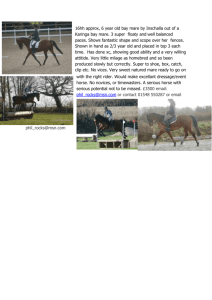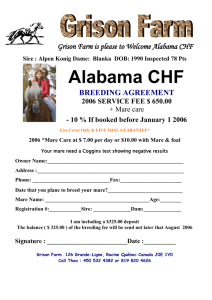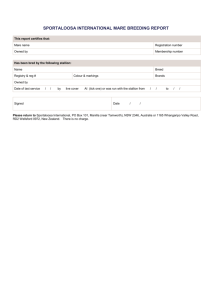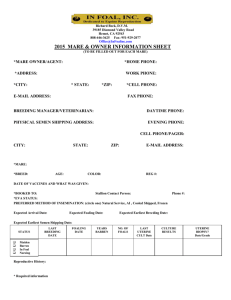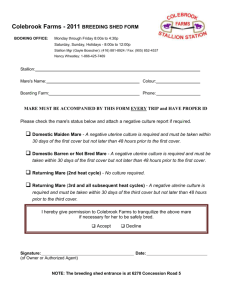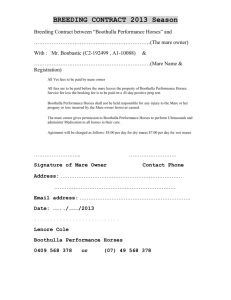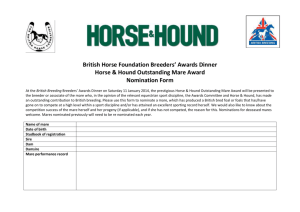Tease a mare
advertisement
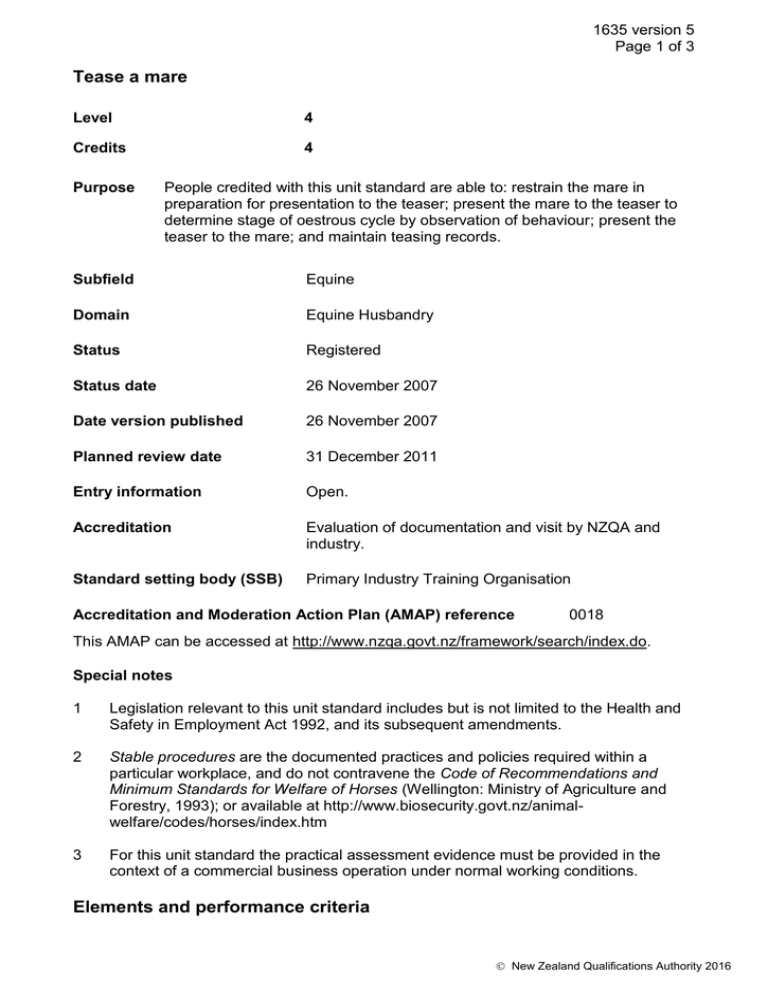
1635 version 5 Page 1 of 3 Tease a mare Level 4 Credits 4 Purpose People credited with this unit standard are able to: restrain the mare in preparation for presentation to the teaser; present the mare to the teaser to determine stage of oestrous cycle by observation of behaviour; present the teaser to the mare; and maintain teasing records. Subfield Equine Domain Equine Husbandry Status Registered Status date 26 November 2007 Date version published 26 November 2007 Planned review date 31 December 2011 Entry information Open. Accreditation Evaluation of documentation and visit by NZQA and industry. Standard setting body (SSB) Primary Industry Training Organisation Accreditation and Moderation Action Plan (AMAP) reference 0018 This AMAP can be accessed at http://www.nzqa.govt.nz/framework/search/index.do. Special notes 1 Legislation relevant to this unit standard includes but is not limited to the Health and Safety in Employment Act 1992, and its subsequent amendments. 2 Stable procedures are the documented practices and policies required within a particular workplace, and do not contravene the Code of Recommendations and Minimum Standards for Welfare of Horses (Wellington: Ministry of Agriculture and Forestry, 1993); or available at http://www.biosecurity.govt.nz/animalwelfare/codes/horses/index.htm 3 For this unit standard the practical assessment evidence must be provided in the context of a commercial business operation under normal working conditions. Elements and performance criteria New Zealand Qualifications Authority 2016 1635 version 5 Page 2 of 3 Element 1 Restrain the mare in preparation for presentation to the teaser. Performance criteria 1.1 Mare is caught and quietly restrained until the halter is fitted in a manner which is safe for the horse and handler. Range yard, paddock. 1.2 Twitch is applied firm enough to ensure it has an effect, without causing discomfort for the mare. 1.3 Mare is restrained by the lead rope of halter and with the twitch held firm without pulling during movement. Element 2 Present the mare to the teaser to determine stage of oestrous cycle by observation of behaviour. Range wet mare, dry mare, maiden mare. Performance criteria 2.1 Methods of teasing are outlined in terms of the reasons for the method used on property. Range may include but is not limited to - paddock, individual, group, crush, teasing yard, breeding board. 2.2 Mare is led to the teaser, and presented hindquarters first to allow the teaser to tease the mare in a manner which is safe for the mare, teaser, and handler. 2.3 Behavioural signs of a mare in oestrous are recognised and reported to the studmaster according to stable procedures. 2.4 Exceptions to normal oestrous behaviour in shy mares, and wet mares are described in accordance with their display of behaviour. Element 3 Present the teaser to the mare. Performance criteria 3.1 Restraint fitted to the teaser ensures control at all times. Range halter, rearing bit. New Zealand Qualifications Authority 2016 1635 version 5 Page 3 of 3 3.2 Teaser is encouraged to tease the mare in various situations in a manner that allows the mare to display the state of her oestrous cycle without causing injury to mare or handler. Range in hand to individual mares, led on long rope into paddock, tied behind teasing board. Element 4 Maintain teasing records. Performance criteria 4.1 Description of a mare's teasing record identifies the format and meaning of symbols used. Range 4.2 mare’s personal details, breeding history, date arrived, date served, date foaled, heat, hot on, going off, off heat. Results of teasing are recorded on the mare’s teasing record according to stable procedures. Please note Providers must be accredited by NZQA, or an inter-institutional body with delegated authority for quality assurance, before they can report credits from assessment against unit standards or deliver courses of study leading to that assessment. Industry Training Organisations must be accredited by NZQA before they can register credits from assessment against unit standards. Accredited providers and Industry Training Organisations assessing against unit standards must engage with the moderation system that applies to those standards. Accreditation requirements and an outline of the moderation system that applies to this standard are outlined in the Accreditation and Moderation Action Plan (AMAP). The AMAP also includes useful information about special requirements for organisations wishing to develop education and training programmes, such as minimum qualifications for tutors and assessors, and special resource requirements. Comments on this unit standard Please contact the Primary Industry Training Organisation standards@primaryito.ac.nz if you wish to suggest changes to the content of this unit standard. New Zealand Qualifications Authority 2016
